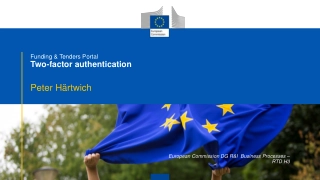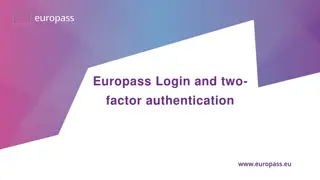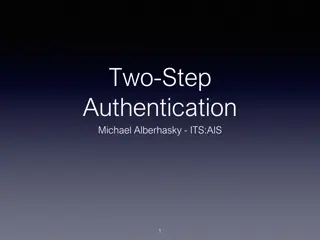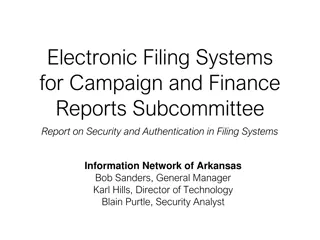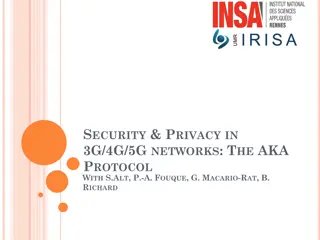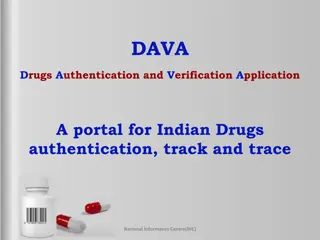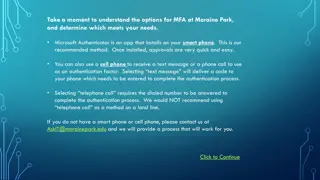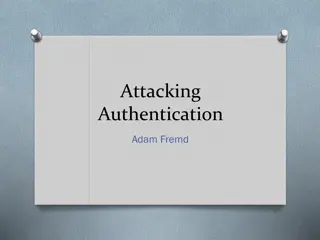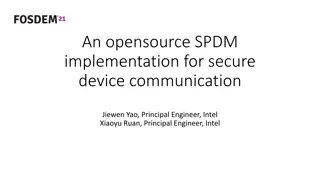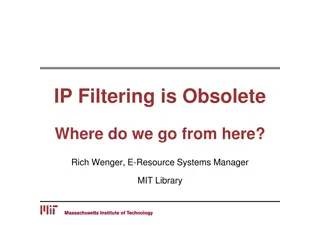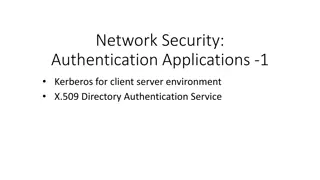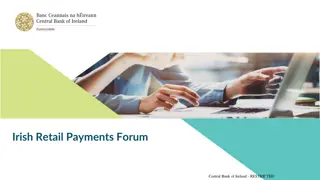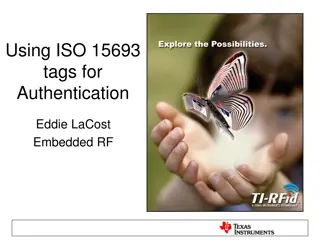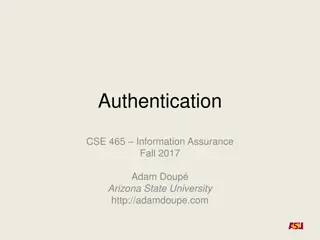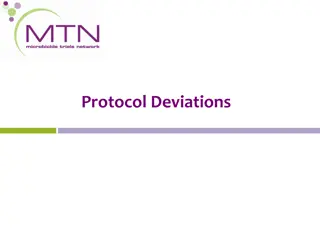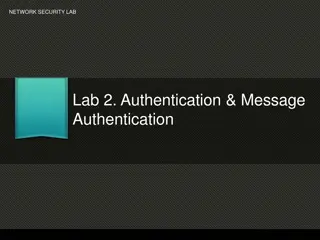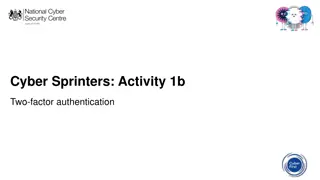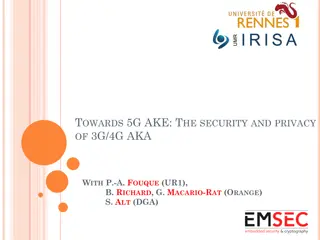Understanding Kerberos Authentication Protocol
Kerberos is a secure authentication protocol developed at M.I.T. to allow workstation users to access network resources securely. It involves three servers: Authentication Server (AS), Ticket-Granting Server (TGS), and the server performing the requested tasks. The AS verifies users, TGS issues tickets, and users authenticate themselves to access services. The process involves obtaining encrypted tickets, demonstrating identity, and proving authorization for requested services. This intuitive process ensures secure interactions within a network environment.
Download Presentation

Please find below an Image/Link to download the presentation.
The content on the website is provided AS IS for your information and personal use only. It may not be sold, licensed, or shared on other websites without obtaining consent from the author. Download presentation by click this link. If you encounter any issues during the download, it is possible that the publisher has removed the file from their server.
E N D
Presentation Transcript
Kerberos Kerberos was designed at M.I.T. to allow workstation users to access network resources in a secure way. Kerberos involves three servers in addition to Alice ( a client workstation): Autentication Server (AS):verifies users during the login Ticket-Granting Server (TGS): issues proof of identity tickets Bob the server: actually does the work Alice wants performed
AS is responsible for handling a login request from a user. The AS maintains a database of secret keys; each entity on the network whether a client or a server shares a secret key known only to itself and to the AS. TGS distributes special messages, (tickets), that are used to convince a server that the client is really who he claims to be. A ticket is an encrypted data structure naming a user and a service that the user is allowed to obtain. It also contain a time value (time stamp) and some control information. 3
The following is an intuitive description. The client authenticates itself to the Authentication Server and receives a ticket. (All tickets are time-stamped.) It then contacts the Ticket Granting Server, and using the ticket it demonstrates its identity and asks for a service. If the client is eligible for the service, then the Ticket Granting Server sends another ticket to the client. The client then contacts the Service Server, and using this ticket it proves that it has been approved to receive the service. 4
User Login 1) A user workstation sends the user identity (Alice) to AS when the user logs on(1). 2) The AS verifies that the user is authorized. The AS generates the secret key, Ka, by hashing the password of the user found at the database. AS sends back a messages encrypted with Ka(the secret key of the client/user) to the client containing a key Ks and a ticket KTGS intended for the TGS. - Ks, for use in communication with Ticket Granting Server (Client/TGS Session Key). - KTGS(A,Ks) Ticket-Granting Ticket, which includes the client ID (A), the (Ks), and it is encrypted using the secret key KTGS , shared between AS and TGS 5
Get a ticket After she logs in, Alice may tell the workstation that she wants to contact Bob the file server. The workstation then sends message (3) to TGS asking for a ticket to use with Bob. The message (3) is composed by: KTGS(A, Ks). the ID of the requested server,Bob. Ks(A,T) Using the key KTGS the TGS can obtain the session Key Ksused to decrypt Ks (A,T) and then proof that the sender is really A.
The Alices client asks to Alice the password when the message from AS has been received . The password is used to generate Ka. If using Ka the message can be decrypted, then the user is authenticated by AS and Alice obtains the KS key and the ticket KTGS(A,Ks). The client deletes the Alice s password. So, the password is present in the client only a few millisecond. Note that the passwords are stored at the Kerberos server, not at the client, and that the passwords did not have to be passed across the network, even in encrypted form (security advantage).
The TGS responds by creating a session key, KAB for Alice to use with Bob. Two versions of it are sent back. The first is encrypted with only KS, so Alice can reat it. The second is encrypted with Bob key, KB, so Bob can read it.(4) KS (B, KAB) KB (A, KAB) Alice can send KAB to Bob to establish a session with him. This exchange is also time stamped. KB(A, KAB), KAB(t) (5) The response is the proof to Alice that she is actually talking with Bob KAB(t+1) (6)
The client decrypts the confirmation using KAB, and checks whether the timestamp is correctly updated. If so,then the client can trust the server and can start issuing service requests to the server. The server provides the requested services to the client. If Alice decides she needs to talk with another server, Carol, she simply repeats message (3) to the TGS, only now specifying C instead of B. The TGS will respond with a ticket encrypted with Kc that Alice can send to Carol and that Carol will accept as proof that it came from Alice. Alice can access servers all over the network in a secure way, and her password never as to go over the network.
Authentication servers The servers offering services may belong to different domains, each of them with own AS and TGS. If a client wishes to access a server belonging to a different domain it is necessary to require to the local TGS a ticket that is accepted by the remote TGS. In order to achieve this result, the remote TGS must be registered on the local TGS as a local server. In this way, the local TGS can give to Alice a valid ticket for the remote TGS and Alice is able to obtain a ticket for the remote server. 10
Kerberos was carefully designed to withstand attacks in distributed environment. No password communicated on the network Cryptographic protection against spoofing. Limited period of validity. Each ticket is issued for a limited period of time. The ticket contains a time stamp with wich a receiving server determines the ticket validity.(long attacks, such brute force cryptanalysis, are usually neutralized because the attacker does not have time to complete the attack). Time stamps to prevent reply attacks. Kerberos requires reliable access to a universal clock. Each user request to a server is stamped with the time of the request. This time is compared to the current time. The request is accepted only if the time is reasonably close to the current time. 11
DRAWBACKS Single point of failure: Il requires continous availability of the central server. When the Kerberos server is down,no one can log on (multiple Kerberos servers). Kerberos requires the clocks of the involved hosts to be synchronized. The tickets have a time availability period and if the host clock is not synchronized with the Kerberos server clock, the authentication will fail with the Kerberos server clock. Since all authentication is controlled by a centralized KDC, compromise of this authentication infrastructure will allow an attacker to impersonate any user. 12


